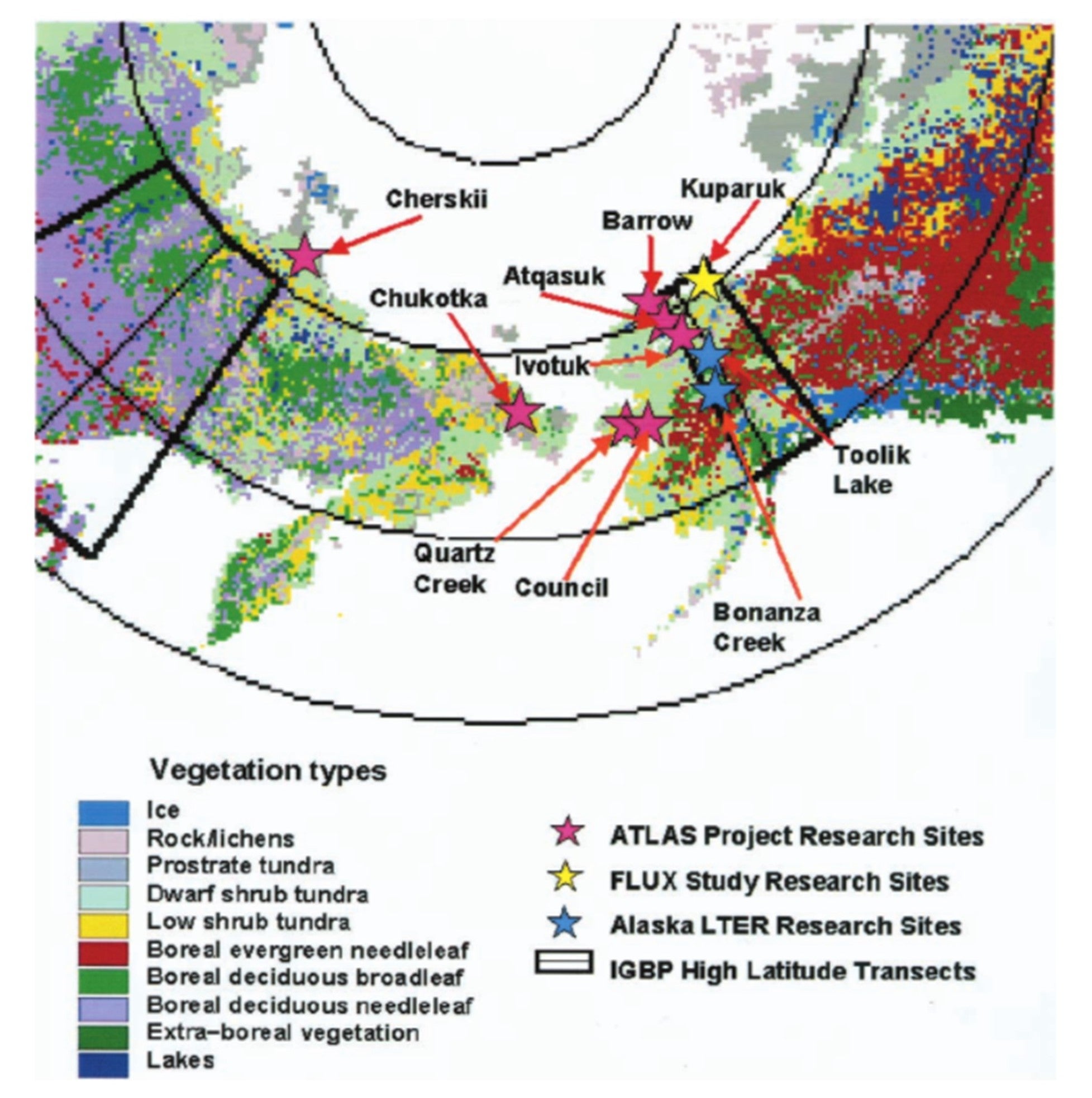ATLAS
Arctic Transitions in the Land-Atmosphere System
The Land-Atmosphere-Ice Interactions (LAII) Program was part of the Arctic System Science (ARCSS) Program of the National Science Foundation (NSF) which focused on studying processes controlling the fluxes of carbon dioxide, methane, water, energy, and nutrients between tundra ecosystems and the atmosphere and ocean in the Kuparuk River Basin in northern Alaska between 1993 and 1996. LAII had overall goals of understanding how the feedback processes within Arctic system affected global climate change, including changes in the hydrology, biochemical, plants, animals, and ecosystems; as well as how these changes affect and are affected by human activities. The LAII Arctic Transitions in the Land-Atmosphere System (ATLAS ) Project succeeded the LAII Flux Study, and like the Flux Study, the ATLAS Project also has concentrated on the exchange of mass and energy between the terrestrial ecosystems in the Arctic and the atmosphere and ocean. However, ATLAS expanded its spatial scope of interest from a hydrologic basin to the Western Arctic region (i.e., Alaska and the Russian Far East) and to the circumpolar Arctic. Some efforts of ATLAS were devoted to evaluating to what extent the understanding gained from the LAII Flux Study was or was not representative of other terrestrial ecosystems in the Arctic. In addition, ATLAS had also attempted to gain a better understanding of temporal variation in processes that were responsible for the exchange of mass and energy in terrestrial ecosystems of the Arctic. Modeling approaches were employed in ATLAS to provide the capability to examine the regional to pan-Arctic scale and the decadal to century scale implications of new understanding gained from the field studies.
Scientific Objectives:
The key goal of the ATLAS Project was to improve understanding of controls over spatial and temporal variability of terrestrial processes in the Arctic that have potential consequences for the climate system, i.e., processes that affect the exchange of water and energy with the atmosphere, the exchange of radiatively active gases with the atmosphere, and the delivery of freshwater to the Arctic Ocean. The overall objective of the ATLAS program was to determine the geographical patterns and controls over climate-land surface exchange (mass and energy) and to develop reasonable scenarios of future change in the Arctic System. This objective was significantly broader than that of the previous LAII Flux Study in several respects: (1) To extrapolate climate, permafrost, vegetation, and mass and energy fluxes from the plot scale to the circumpolar Arctic; (2) To develop reasonable scenarios of future trajectories of these ecosystem properties over the next 10-200 years; and (3) To improve understanding of the coupled nature of the land and atmosphere in the Arctic System.
Network Map:
To accomplish the goals of ATLAS, seven intensive research sites were established, with five sites located in Alaska and two sites in the Russian Far East (see Map below). These sites provided the capability to study processes influencing mass and energy exchange across the western Arctic. Studies conducted at these sites complemented research being conducted along the network of high-latitude transects established by the International Geosphere –Bio-sphere Programme (IGBP) and by the two Long-Term Ecological Research (LTER) sites at Toolik Lake and Bonanza Creek in Alaska. The ATLAS sites in Alaska included sites located on a transect from Barrow to Atqasuk to Ivotuk on the North Slope and sites at Council and Quartz Creek on the Seward Peninsula. The Barrow to Ivotuk transect was specifically established to test the ability to extrapolate understanding from the Kuparuk River Basin to other parts of the Alaska North Slope, while the sites on the Seward Peninsula were established to evaluate understanding of tundra ecosystems in a warmer climate located near the boundary between tundra and boreal forest. The sites in Russia provided opportunities for comparative studies of: (1) tundra under different regimes of climate change; and (2) processes in transitional ecosystems between tundra and boreal forest. One of the intensive sites in Russia was located on the Chukotka Peninsula across the Bering Strait from the Seward Peninsula. In contrast to a similar setting at Quartz Creek on the Seward Peninsula in Alaska, which had experienced warming in recent decades, the Chukotka site was established in a region that had not experienced warming. The other intensive site in Russia was located in Cherskii and provided the opportunity to study processes in transitional ecosystems from tundra to larch forest, which contrasted with the study of processes in transitional ecosystems from tundra to spruce forest at the Council site on the Seward Peninsula.

Polar projection vegetation map including the location the intensive research sites of the ATLAS Project (Barrow,Atqasuk, Ivotuk, Council, Quartz Creek, Cherskii, and the site on the Chukotka Peninsula), the Flux Study (the Kuparuk River Basin), and the two LTER programs in Alaska (Toolik Lake and Bonanza Creek). The vegetation map is courtesy of Catharine Copass.
Project Outcome:
Three important conclusions have emerged from research associated with the ATLAS Project. First, associated with the observation that the Alaskan Arctic has warmed significantly in the last 30 years, permafrost is warming, shrubs are expanding, and there has been a temporary release of carbon dioxide from tundra soils. Second, the winter is a more important period of biological activity than previously appreciated. Biotic processes, including shrub expansion and decomposition, affect snow structure and accumulation and affect the annual carbon budget of tundra ecosystems. Third, observed vegetation changes can have a significant positive feedback to regional warming. These vegetation effects are, however, less strong than those exerted by land–ocean heating contrasts and the topographic constraints on airmass movements.
Further information and details on ATLAS can be found at:
McGuire, A. D., Sturm, M., and Chapin, F. S. (2003), Arctic Transitions in the Land–Atmosphere System (ATLAS): Background, objectives, results, and future directions, J. Geophys. Res., 108, 8166, doi:10.1029/2002JD002367, D2.